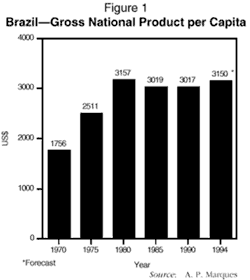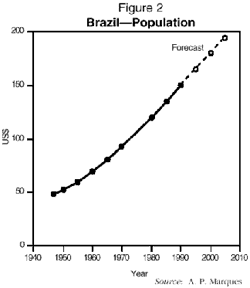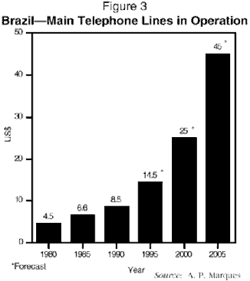
As people became more aware of their rights and duties in a democracy, there was also an increase in the sense of community. Despite being a very large country (comparable to the continental United States), only one language -- Portuguese -- is spoken. This helps a great deal in the communication between different parts of such a large territory.
At that time, Brazil was under a military government which decided that telecommunications was a strategic target and created the Telebrás System (Telecomunicações Brasileiras S.A.). Telebrás is composed basically of a long distance company, Embratel (founded in 1965), and several other companies, one for each state of Brazil. These companies were supposed to acquire all the small companies that were operating in each state. This was done in such a way that, today, 98% of the system is operated by only 30 companies. This was possible because of an article in the Brazilian Constitution that required telecommunications services to be offered only by state-owned companies. Until 1977, improvements in the system were considerable. However, since that time, a shortage of money for expansion became serious, and problems in the telephone companies' administration prevented the system from fulfilling customer needs.
Today, Brazil has 13.5 million installed telephone lines, almost nine lines per 100 inhabitants. However, if you select only the people who earn more than US$1,600 per month, nearly 85% have access to telephone service. This is, in essence, the Brazilian problem and explains why some people call our country "Belindia": a small, rich, developed country like Belgium, inside a huge, poor, and crowded country like India. Only 18% of the workers earn more than US$800 per month, and the average telephone bill is around US$47. Total revenues of the Telebrás System were US$10 billion in 1994, of which 55% came from long distance traffic and 26% from local traffic.
Here, another problem arises, and it is very old and still unsolved: cross-subsidies between long distance and local service. Today, the basic rate per month is US$0.70, and a local call is around US$0.05 for three minutes. (Compare this, for instance, to the US$0.50 that is paid for a ride on a local bus.) On the other hand, it costs around US$1,200 to have a telephone line, which includes some shares in the telephone company. There is room for at least five million more lines in the whole country.
There are some 800,000 cellular phones in operation in Brazil, and there is room for one million more accesses. Brazil was one of the last big markets to have cellular systems, which really started around 1991. Data communications networks, which include packet networks, are already in operation, and, in the next year, the deployment of ATM networks will start in the major markets.
Low income customers are finding their own way to have access to telephone service, either by sharing one line among several houses (in one case, 39 families shared just one line), or by using manual systems or small PABX or key systems. It must also be said that the network in operation has a very small percentage of digital lines (25% in 1994), and the step-by-step equipment, which was installed in the 1930s and 1940s, is still in use. This is in spite of a high degree of digital equipment in higher levels of the network, especially in the long distance network and transit equipment of the big cities.
After several years of high inflation rates, things seem to have stabilized. Since June 1994, monthly inflation has been around 2%, down from an average of 40% to 50%. In 1989, one month saw a record 80% inflation. These numbers forced people to invest not in production, but in simple speculative markets. With the new figures, though, the economy will probably start to grow at a faster rate, and more telecommunications services will be needed. In 1994, Brazil's gross national product (GNP) was roughly US$3,100 per capita (see Figure 1). Agriculture was responsible for 9% of GNP, and industry contributed 36%. By contrast, the service sector accounted for 55%, and this number has been increasing every year. It is important to note that communications in general is the sector with the fastest expansion rate in the economy since 1991.

In the next few months, it is very likely that the constitution will be changed, and private companies will be allowed to be telecommunications operators, especially in mobile and data communications, and long distance services. It is still not clear what will happen to Telebrás, which is still state-owned and controlled by federal laws. Telebrás is also expected to provide service to all low income people living in the cities and in sparsely populated areas (just think about the Amazon forest...). One solution may be the privatization of the Telebrás system, or a mechanism may be created to give financial resources to Telebrás companies to allow them to operate independently.
The main vendors of telephone equipment operating in Brazil are NEC, Ericsson, Siemens, Alcatel, and AT&T, which entered the market after 1990. There are already several groups that are very much interested in starting services in Brazil after the change in the constitution. As usual, they are comprised of banks, companies from abroad, and vendors. Oddly, some traditional civilian construction companies, especially from dam and road construction firms, are also exploring opportunities.
There are already many companies working with the telcos. Since it was not possible to hire people to do all the work necessary in order to build and operate the telecommunications system, these companies subcontracted part of their activities, such as outside plant maintenance and data processing, to other companies in Brazil.
Beyond just improved quality and reasonable prices, large companies and higher income customers expect -- and can afford -- better services like mobile services, high-speed data links, video transmission, and so on. At the other end of the spectrum, lower income customers just want to have telephones in their homes (not needing that much quality) or payphones within a reasonable distance.

The markets using this network will be closely linked with the world market. Since Brazil is very big, there will need to be a lot of integration between different regions. The need for a large amount of transaction between databases scattered around the country and the transmission of multimedia information will also become relevant. GNP per capita will rise at an average rate of 8% to 10% in the next 10 years, to a level of around US$8,000.
Economic growth must be considered as well, for it is concentrated today in some of the southeastern states, namely São Paulo, Minas Gerais, Rio de Janeiro, Paraná, Santa Catarina, and Rio Grande do Sul. This growth will certainly spread to other states, especially in the northeast and west. Conditions must allow for these states to be able to contact each other easily. That means data communications in all its various forms: small database queries, file transfers between databases, validation processes, distant printing of newspapers and magazines (don't forget the size of the country!), communication between software development houses, and so on.
Another area is video applications. Services such as tele-education, tele-medicine, tele-shopping, new forms of entertainment, tele-voting, and regional TV networks will become increasingly attractive to customers, especially in remote areas. Finally, "plain old telephone service" will still generate a great percentage of the total traffic, while the "not so old and plain" mobile and personal communications services will play very important roles. Data communications for the residential market will be important as more and more people have home computers.
In general, it can be expected that Brazilians, at home or at work, will have a way of life very similar to people in the rest of the world. To meet the needs of these customers, telecommunications services in Brazil must be similar to other ones in the developed world.
In the 1970s, 4.3 million lines were added over a 10-year period, which was an average 12% rise each year. A rise of 15% per year in the number of telephone lines is projected for the next 10 years -- an increase of 32 million lines (see Figure 3). While impressive, by no means does that achieve the desirable level of telecommunications penetration. For other services, especially video and data, the rise will be much higher: probably around 50% in the first five years and then declining.

REGULATION
The state will have to concentrate more and more on its regulatory function to create and enforce laws that will help to guarantee access to telecommunications for all citizens. That means:
This will require government and industry to work together in ways never seen before. Patience, imagination, and willpower will be needed to achieve consensus on the direction of telecommunications in Brazil.
PRIVATIZATION
The state-owned companies have accomplished a lot since their creation. In the future, however, they will have to adopt new perspectives and learn to act and work more as private companies -- and equal competitors. These companies must be sold to the private sector for a fair price. The government could use any revenue from these sales to improve and upgrade the regulatory process and to finance services in non-profitable areas. There should also be mechanisms in place to guarantee that any changes will not impact the quality of service. No one wants to hear, "How I miss the days when this company belonged to the government!"
NETWORK ACCESS
People must be allowed to find solutions for their specific needs in such a way that they can gain access to all kinds of different networks and service providers. People living in distant villages or other remote regions of the country with no telephone service must be free to look for any satellite or wireless operator, for instance, and have access to the national network through this operator. Likewise, people in a neighborhood must have the right to deploy their own communications systems, and get one single connection to the network for all of them if they want to do so.
COMPETITION
New companies will appear and will want a share of the market. It is very important for these new companies to compete in such a way that customers derive the advantage. This must be taken into account when entering the market in both very developed areas and in distant, not-so-developed areas. In some cases, there will not be room for even two companies to operate. It is important to repeat that, even within 10 years, Brazil will have a lot of very poor people living in big cities who will be in need of special solutions. There will also be people living in remote regions, where some kind of basic service will be required. This will be a hard target: giving these people access to the network at reasonable prices and comparable quality.
EDUCATION
The educational system necessary to prepare this new generation of people is yet to be created. It will surely be necessary to train many more people than those available today, especially in the following areas:
Today, when a company wishes to hire employees with the necessary skills in the telecom business, often, the only solution is "stealing" these people from other companies, as it is very difficult to find them in schools or training centers. And, of course, it is very costly to import the expertise from abroad.
NATIONAL TELECOMMUNICATIONS PLAN
It will be necessary to develop and maintain a national telecommunications plan that will give guidelines to operators, vendors, customers, and regulatory bodies. These guidelines will address the general structure of the telecom business in Brazil and include objectives, quality of service issues, prices to the customer, and other matters related to these issues. Through this vehicle, anyone can get information on the basic structure of the network and receive a profile of the main services offered, numbering plans, parameters to measure overall quality of the offered services, pricing structures, etc.
NATIONAL POLICY
A great deal of work will be necessary to achieve the projected growth, and a national policy to attract resources both from inside Brazil and from the world market will be required. For example, the new accesses to be installed will cost around US$1,800 per line, which would include replacing old equipment serving the 13.5 million lines now in operation. This totals around US$57 billion. For the data communications/multimedia accesses, the cost will be approximately US$2,000. With 10 million accesses predicted, this is a total investment of around US$20 billion. Add an additional US$10 billion for the operational infrastructure, such as management and operation systems and equipment supporting internal personnel activities such as PABX, operator position systems, and so on, and the total is US$87 billion. That is quite a figure, especially for a country in such an economic situation as Brazil (external debts add to US$125 billion today, for instance). If we divide that amount by the 10 years projected, the investment is US$8.7 billion per year -- almost three times the investment that Telebrás has been making in the period of 1993-1995.
There are already other companies making investments in the Brazilian network in the areas of local CATV, satellite networks, and local radio links. The sum of these investments plus the money spent by Telebrás makes the gap a little smaller, but the total amount required is still more than double. This will be a real financial challenge, and the steps to take to achieve these numbers are still to be found.
On the other hand, the revenues this business will bring will help stimulate the local economy. Assume a monthly revenue of US$60 per access of telephone service and US$300 per data/multimedia access. This will lead to revenues of US$68.4 billion per year, and that is a number to get everyone's attention. The accesses indicated as data/multimedia include CATV as well as high-speed links, so there will be a broad range of prices for these types of services, potentially increasing revenues even more.